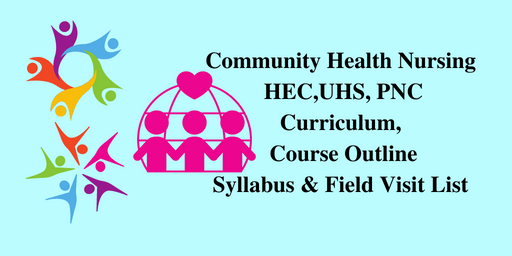The Community Health Nursing Curriculum. Community Health Nursing HEC Community Health Nursing is a vital aspect of the nursing profession, focusing on the health and well-being of individuals, families, and communities.
The Community Health Nursing Curriculum HEC,UHS, PNC, Course Outline, Syllabus & Field Visit List
The HEC curriculum for Community Health Nursing in the Bachelor of Science in Nursing (BScN) program is designed to equip students with the knowledge and skills necessary to promote health, prevent illness, and address the social determinants of health. This comprehensive overview will outline the course description, objectives, syllabus, clinical objectives, major topics, and recommended resources.
Course Description
In the 136 credit hour program, the Community Health Nursing course comprises 3 credit hours, including 2 theory hours and 1 hour dedicated to community-based activities. The course introduces students to the fundamental concepts of Community Health Nursing, emphasizing Primary Health Care and the environmental effects on health. It covers factors influencing the health of individuals, families, and communities while providing insights into Pakistan’s Health Care System, health education components, and community services through field visits.
Course Objectives
By the completion of this course, students will be able to:
- Discuss the role of community health nurses and other health team members.
- Describe the concept of Primary Health Care as a strategy for achieving the Alma Ata Declaration of “Health for All by the Year 2000 and beyond (2025).”
- Identify services provided by the government health care system in Pakistan.
- Discuss the effects of the environment on health.
- Understand the process of Health Education.
- Utilize the Nursing Process to provide care to clients in communities through home visits and health education.
Clinical Objectives
Upon completing field visits, students will be able to:
- Discuss the structure and functions of health care facilities run by government and non-government organizations.
- Identify the roles and responsibilities of staff working in each visited facility.
- Describe processes related to:
- Sewage treatment
- Water purification at a large scale
- Milk transportation and preservation
- Meat slaughtering, handling, and distribution
- Identify existing environmental issues and their effects on health.
- Discuss the role of Community Health Nurses (CHN) in maintaining a healthy environment.
- Begin to apply the nursing process during home visits.
- Utilize various methods of health education while providing information to clients.
Course Outline
Community Health Nursing I
- Introduction to Community Health
- Define community, community health, and community health nursing.
- Differentiate between urban and rural communities.
- Discuss the historical background of community health.
- Primary Health Care (PHC)
- Explain the Alma Ata Declaration: “Health for All by the Year 2000” and beyond.
- Define Primary Care and PHC.
- Describe the five basic principles of PHC and their application in Pakistan.
- Pakistan Health Care System
- Define the terms system and health care system.
- Identify health services available to the community through the Pakistan Government Health Care System.
- Explain the roles of health care team members within the health care system.
- International Health Organizations and Nursing Organizations
- Discuss the International Council of Nursing and World Health Organization.
- Describe the Pakistan Nursing Association, Federation, and Council.
- The Environment and Its Impact on Community Health
- Define the environment and its components, discussing their impact on community health.
- Describe safe and wholesome water, sources of water, water pollution, and waterborne diseases.
- Discuss solid waste management and fecal-borne diseases.
- Explore food sanitation, air quality, and the importance of housing standards.
- Health Education
- Define teaching, learning, and health education.
- Explain the purpose and goals of health education.
- Discuss principles of teaching and learning, strategies for delivering health education, and developing a teaching plan.
- Introduction to Home Visiting
- Define home visiting and discuss its principles, purposes, and advantages.
- Describe the steps involved in conducting home visits.
Community Field Visits
Students will undertake field visits to various health facilities to gain practical experience and understanding of community health nursing:
- Primary Health Center (PHC)
- Walking Survey in a Community
- Basic Health Unit (BHU)
- Rural Health Center (RHC)
- Bulk Water Supply Plant
- Sewage Treatment Plant
- Milk Plant & Dairy Farm
- Non-Governmental Organization (NGO)
- Slaughter House
Recommended Books
- Allender, J. A., & Spradley, B. W. (2000). Community Health Nursing: Concepts and Practice. New York: Lippincott.
- Ansari, I. M. (2003). Community Medicine and Public Health (6th ed.). Karachi: [Publisher].
- Basavanthappa, B. T. (1999). Community Health Nursing (1st ed.). New Delhi: Jaypee Brothers.
Conclusion
The Community Health Nursing curriculum is designed to provide nursing students with the knowledge and skills necessary to promote health and prevent disease in community settings. By integrating theoretical knowledge with practical experiences, students will be well-prepared to address the health needs of individuals, families, and communities. This holistic approach to nursing education emphasizes the importance of understanding the social determinants of health and the role of community health nurses in fostering healthier communities. Through field visits and active participation in community health initiatives, students will gain valuable insights that will enhance their practice and contribute to improved health outcomes in Pakistan.
Read More:
https://nurseseducator.com/didactic-and-dialectic-teaching-rationale-for-team-based-learning/
https://nurseseducator.com/high-fidelity-simulation-use-in-nursing-education/
First NCLEX Exam Center In Pakistan From Lahore (Mall of Lahore) to the Global Nursing
Categories of Journals: W, X, Y and Z Category Journal In Nursing Education
AI in Healthcare Content Creation: A Double-Edged Sword and Scary
Social Links:
https://www.facebook.com/nurseseducator/
https://www.instagram.com/nurseseducator/

I visit every day a few websites and sites to read content, but this
web site gives feature based writing.